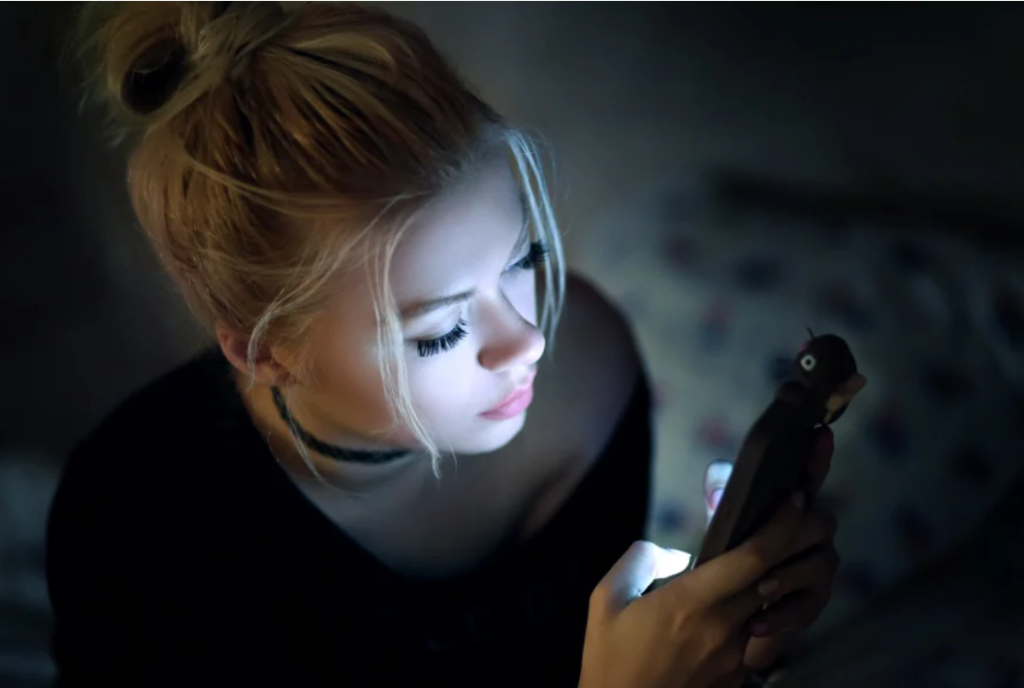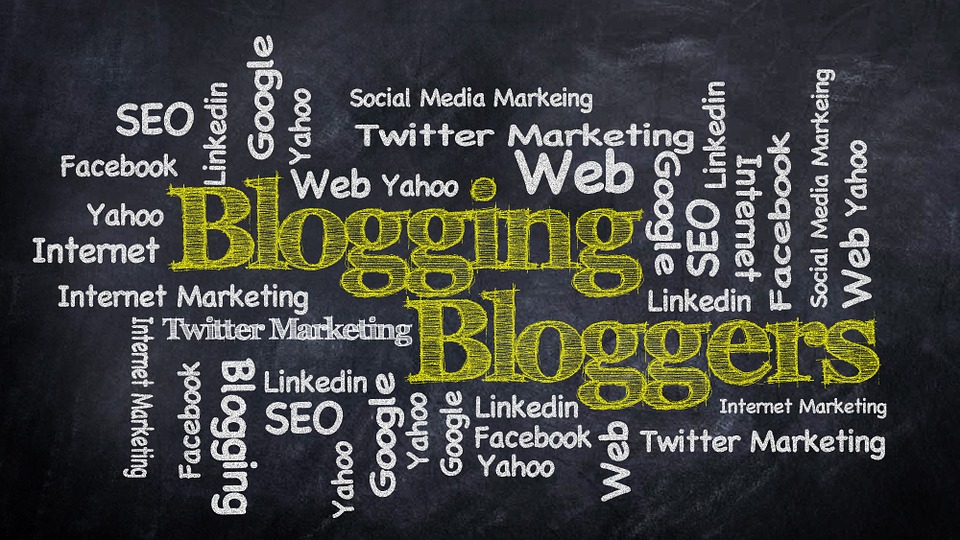Skin health isn’t just about protection from UV rays anymore. The reported negative effects of blue light on the skin is a new concern growing out of our increased dependance on screens: computers, cell phones and televisions among them. The beauty industry is taking notice. Products and treatments are being formulated specifically to protect and heal skin from the effects of this blue light. So, what exactly is blue light and what harm can it do to our skin? And most importantly, what can we do about it?
What Is Blue Light?
First we need to understand that all light exists on a spectrum, but human eyes can only see rays on the electromagnetic (EM) spectrum of visible light: red, orange, yellow, green, blue, indigo and violet. Light creates EM energy waves that our brains perceive as color. Each wave has a different wavelength, which makes us see a different color. As we move up the spectrum from red to violet, the energy increases. The more energy a wave has, the higher the frequency. Waves with a higher frequency are potentially more damaging to our bodies, which is why infrared rays are good for you and ultraviolet (UV) rays can be harmful. On this scale of visible light, blue light is high.
All light contains these waves, but it’s the energy they emit that allows us to see color. Blue light is no exception. In fact, the sun is our largest source of blue light and as the sun’s rays collide with air molecules and are scattered through the earth’s atmosphere, the sky appears blue. This is why blue light is evolutionarily significant to humans: it helps us differentiate between day and night, enabling us to regulate our sleep cycles and maintain our circadian rhythm.
How is Blue Light Harmful?
Even though blue light is a high energy visible light, our eyes provide very little protection from it, especially on clear, sunny days. Our LED screens (like computer screens, television screens and phone screens) produce an even higher intensity of this same blue light. Too much exposure can cause damage to our eyes, affect our sight, and make us feel lethargic and fatigued.
The eye’s frontal membrane (the cornea) naturally absorbs light from lower frequencies (red, orange, green), but high energy light (blue and violet) goes straight through. The retina at the back of the eye absorbs it and can deteriorate over time with too much exposure. And about that circadian rhythm: since our brains associate blue light with daytime, looking at a screen late at night tricks our bodies into thinking we need to stay awake. Some studies show that this can affect our mental health and lead to sleep problems.
Studies also indicate that blue light can also cause skin damage. Though not as harmful as the higher frequency UVA and UVB rays, blue light rays are found in all LED screens as well as the LED lights in our homes and offices, which means many of us are being exposed to more blue light than UV rays on a daily basis. The way it affects our skin is similar to UV rays. The high frequency of blue light allows it to pass through the top epidermal and dermal layers of our skin and into the subcutaneous tissues underneath where the rays can cause the production of free radicals. These unstable molecules damage our cell structure, affect protein production and can damage our skin’s DNA. When the body is unable to fight off free radical damage, this is known as oxidative stress. The long-term effects of oxidative stress include premature aging like fine lines and wrinkles, loss of elasticity, and a dull, tired look to our skin.
What Can We Do About It?
As we become more aware of how blue light could be affecting our skin, many people are turning to cosmetic products and treatments to help prevent, slow down or reverse the effects. We spoke to Payman J. Danielpour, M.D., F.A.C.S, a Board Certified Plastic and Reconstructive Surgeon in Beverly Hills, to find out how to combat blue light damage, reduce signs of skin aging, and improve the skin’s appearance.
“Treatments are based on whether we are addressing a problem or trying to avoid problems in the future,” he says. “Having a good aesthetician to provide a structured facial protocol to address skin tone, texture and color is always a good start. In addition, using microneedling, hydrafacials and a variety of lasers and peels can help treat and avoid signs of aging.
Products That Provide First Defense
To combat the effects of blue light on our skin, “the best way is to have a good skin care regimen that addresses a lot of problems that are associated with facial aging,” says Dr. Danielpour. Avoid unprotected exposure, use SPF protection when outside (ideally SPF 50 and make sure it says “broad spectrum”) and use a skin cream that is rich in powerful antioxidants and Vitamin C. Products that are specifically formulated to combat photo aging (aging caused by light expsosure) are particularly useful.
Paula’s Choice creates protective lotions and balms that are specifically formulated to block blue light, encourage the skin’s natural healing process, and provide effective therapy for damaged skin. Their Defense and Resist ranges include products like the Antioxidant Pore Purifier and the Skin Restoring Moisturizer SPF50 which guard against blue light damage. Other popular skincare brands like Murad and Dr. Sebagh Cosmetics are leading the charge as well.
Using a Blue Light Screen Protector on your phone could make a difference as well, but to really curb your blue light exposure, limit screen time and use of electronic devices when indoors. Rather than stare at a laptop screen directly before bed, aim to do something that isn’t screen-related for at least an hour before you go to sleep. Reading a book or listening to music won’t expose your skin to LED light and most importantly won’t disrupt your circadian rhythm as you are preparing to go to sleep.
Treatments Can Help Delay the Damage
Putting down the digital devices is a good start, but Dr. Danielpour also recommends treatments to help combat damage and signs of aging that is already apparent.
BOTOX® (botulinum toxin) is one of the most popular cosmetic tools for smoothing the skin and reducing the appearance of fine lines and wrinkles, thus making skin appear younger and fuller. The treatment involves injecting the chemical into the specific facial muscles which are creating the wrinkle, causing them to relax and the skin on top of it to become smooth. This is especially popular for reducing the appearance of brow wrinkles, crow’s feet and frown lines. One set of non-invasive injections takes around 15 minutes with minimal recovery time. Session costs vary, but are typically around $400 on average.
Microneedling can be used to help stimulate regeneration and healing in the skin by increasing the speed at which new skin cells are created (and dead ones released). The process is relatively painless: skin is often numbed with lidocaine gel before small injections are made into the skin’s dermis. It usually take 3-6 sessions of microneedling for the full anti-aging effects to become visible. As with BOTOX®, microneedling has minimal recovery time and one session can cost around $400 or more.
Hyaluronic Acid is a naturally occurring substance in the human body which lubricates the joints and helps aid the body’s natural healing process. There are some studies that indicate it can be used to reduce signs of aging in the skin as well. Hyaluronic acid is often used in filler products like Juvéderm Ultra Plus Allergan which can help reduce fine lines and wrinkles in the face when injected and massaged into lines. Results are typically visible after 2-3 weeks and can cost an average of around $600.
HydraFacials are another popular solution for those seeking to reverse signs of aging and the effects of light damage. There are three main steps to a HydraFacial session: cleansing, exfoliating and intensive moisturizing with a special serum. The result is softer, smoother and more youthful-looking skin that is free from impurities. Each treatment takes about half an hour and repeat treatments encouraged. One HydraFacial session typically costs around $150.
Thread Lifts are gaining popularity as an alternative to the classic facelift. Rather than having skin removed from the face to reduce wrinkles and sagging, the doctor carefully inserts threads into the face. These threads suspend the skin in a way that minimizes the effects of time and gravity by reducing sagging and giving the face a lift without the need for a scalpel. Thread lifts are usually performed under local anesthetic and have little recovery time. The cost for a Thread Lift in the US averages around $2,500.
Looking To The Future
In addition to using blue light blocking products as part of a well-rounded skin routine and having anti-aging treatments to address existing signs of aging, we can take steps towards healthier, more youthful-looking skin by adjusting the way we live our lives.
“Avoid sunlight and always use sunscreen,” says Dr. Danielpour. “Don’t smoke and don’t do harmful things to your body. Sleep, exercise and have a good skincare regimen.”
Theories and studies around blue light are still in their relative infancy, so we don’t have data from long term studies to tell us exactly how damaging blue light is to our skin. But since our use of digital devices shows no sign of slowing, we know we need to be prepared. As for the future? Treatments are going to get more advanced. “We are on the forefront of very exciting times to use our own stem cells for wellness and cosmetic medicine but we are not quite there yet,” says Dr. Danielpour. Let’s hope it’s sooner than later.
This article was originally published on how your phone might be aging you





